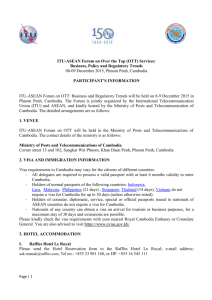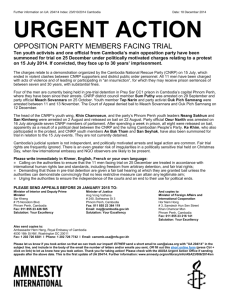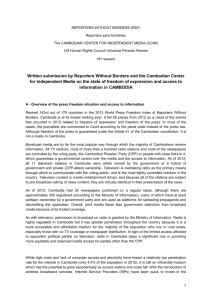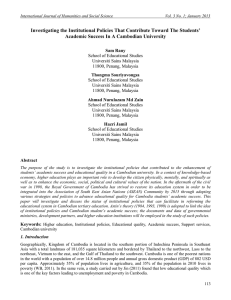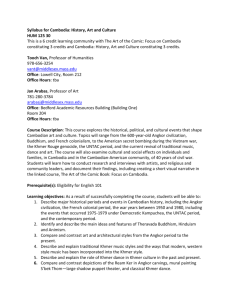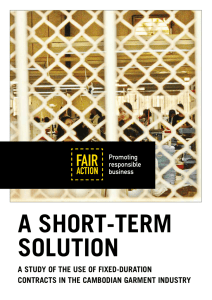Child Labour In Cambodia - Riverside Secondary School
advertisement
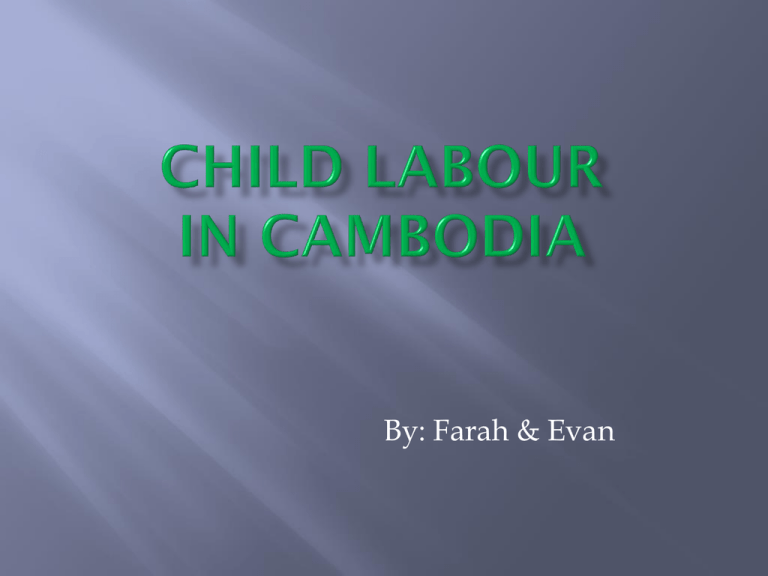
By: Farah & Evan The most common causes of child labour is poverty Mostly the more of the poor countries have child labour, and the children go to slavery to survive, and help them have food and water but sometimes they cannot even afford them even after how much they work. Education is also a big reason why there’s child labour because not a lot of people can afford it in certain countries, mostly in remote rural areas. If the parents cannot afford for their children to go to school or parents see no value in education, children are sent to work. child labour is not accidental. The employers choose to hire the “children” more than the adults because they are cheaper than their adult counterparts. Fifty-two percent of children aged seven to fourteen-years, or more than one-million-four hundred thousand Cambodian children work. The children spend more than twenty hours a week working. A major problem is HIV/AIDS, especially in Africa. Millions of children on this continent have to care for their sick parents or are orphaned as a result of the AIDS. They are left with little choice but to work if there is no help or care for them. When Ros Pagna was only 11 years old, she began working in a garment factory in Phnom Penh. The oldest of five siblings, Pagna left school at Grade 6, and using a fake ID, she got a job alongside her mother. Having learned how to use a sewing machine at a young age, Pagna was a skilled sticher and sewing t-shirts came easily to her. “My supervisor liked me and I was so happy to be earning money to help my family,” she says. On pay day, Pagna gave all of earnings, ranging from $60–$90, to her grandmother. “It was very difficult because we did not have much money and our family had no land.” When her grandmother became sick, it was the money that Pagna earned from working at the factory that helped pay for her medicine. Days began very early, and before even setting out for the factory on her bicycle, Pagna would go to the market and bring home fresh fish for her grandmother to sell. At home, Pagna and her family— including her four siblings, her mother and grandmother—all lived in a one-room rental in Phnom Penh. "Pagna’s Story. : Life after Work as a Child Labourer." Better Factories Cambodia RSS. Web. 21 Nov. 2014. <http://betterfactories.org/?p=6592>. Fifty-two percent of children aged seven to fourteen-years, or more than one-million-four hundred thousand Cambodian children work. The children spend more than twenty hours a week working. 75% of these children work in hazardous conditions. In Cambodia poverty is really common and is the main reason for the child labor, And the cycle of the poor keeps going on because kids are forced to work and to support their family. The children also couldn’t be able to leave poverty, they had absolute no control over anything. But child labour in Cambodia isn’t as bad as it is in other countries because the children aren’t beaten or tortured by the owners. The children suffer from lung problems, 3rd degree burns, eye infections and injury from machinery's They suffer stunted physical growth carrying up to 40kg of salt for miles everyday. The average Cambodian adult works for $1 a day, while the average child works for 25 cents/ Industrial Revolution Similarities Child Labour Today Happened in England Children work in mines Were forced to work six days a week, from six in the morning to seven at night. Children worked at a young age Happening in Eritrea, Somalia, Congo, Myanmar, Sudan, Afghanistan, Pakistan, Cambodia, Yemen, Burundi and Nigeria. Children worked in water powered cotton mines which were poorly ventilated Children were ordered to move between machinery because adults couldn’t fit to fix broken machines. Children dipped matches into phosphorous. This chemical caused the children's teeth to rot later in life. Some died from the long-term effects of breathing phosphorous. Owners forced them to work long hours and got low wages for their work. Working conditions were very unhealthy and dirty. The air is not safe to breath in Couldn’t go to school and get educated Dangerous jobs are •Working with dangerous chemicals in factories •working in mines •prostitution •selling drugs •fighting in conflict areas •working on plantations in hot climates An estimate of 5.7 million children are forced to work in factories, and fields all over the world. Many people think slavery ended after the Civil War, but, tragically, there are more slaves today than at any point in human history. Don’t have children if your not able to take care for them, and pay for schooling and food .school is a major problem because not a lot of parents cant pay for school if their was no cost to school all the children would go to school and learn not work, witch means no child labor. Resources for speakers, global issues, africa, ageing, agriculture, aids, atomic energy, children, climate change, culture, decolonization, demining, development, disabilities, disarmament, environment, food, governance, humanitarian, refugees, women. (n.d.). Retrieved November 19, 2014, from http://www.un.org/en/globalissues/briefingpapers/childlabour/ Children Labor in Cambodia - Modern Day Slavery. (n.d.). Retrieved November 19, 2014, from https://sites.google.com/a/tapa.tp.edu.tw/modern-day-slavery/child-labor/children-labor-incambodia "English Online." Child Labour. Web. 21 Nov. 2014. < http://www.english-online.at/society/child-labour/working-children-around-the-world.htm "Child Labour." , The Impact of the Industrial Revolution, Industrial Revolution. Web. 21 Nov. 2014. < http://www.skwirk.com/p-c_s-58_u-505_t-1366_c-5260/child-labour/act/sose-economy-andsociety/the-impact-of-the-industrial-revolution/industrial-revolution-societies-and-change>. Web. 24 Nov. 2014. &lt; http://1.bp.blogspot.com/YCQkHlBxNPM/UAvebGEFuUI/AAAAAAAAA50/kME8nrg2v5s/s1600/CL2.jp g&gt;. Web. 24 Nov. 2014. &lt; http://www.indiastudychannel.com/attachments/Resources/122795-2827still.jpg&gt;. Web. 24 Nov. 2014. &lt; http://i.dailymail.co.uk/i/pix/2012/11/21/article2236283-1624A6FF000005DC-581_634x420.jpg&gt;.

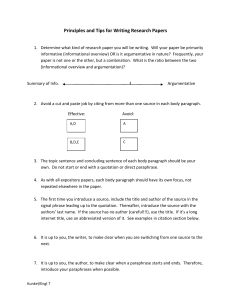


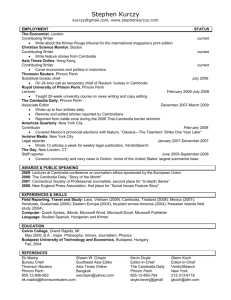


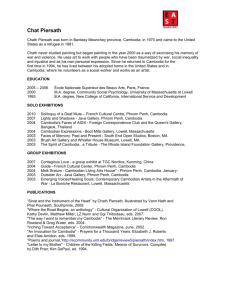
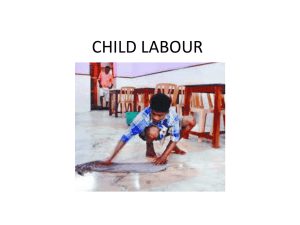

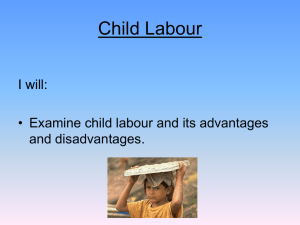
![Cambodian New Year - Rotha Chao [[.efolio.]]](http://s2.studylib.net/store/data/005298862_1-07ad9f61287c09b0b20401422ff2087a-300x300.png)
